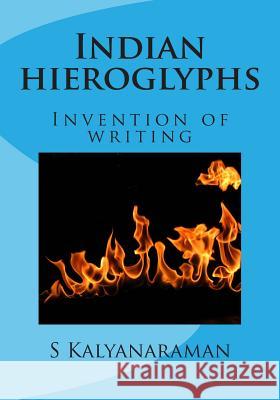Indian Hieroglyphs: Invention of Writing » książka
Indian Hieroglyphs: Invention of Writing
ISBN-13: 9780982897126 / Angielski / Miękka / 2012 / 800 str.
The book links the invention of writing to the inventions of bronze-age technologies. Indus script is claimed to be one of the earliest writing systems of the world dated to c. 3500 BCE. The book claims that Indian language union (sprachbund or Indian linguistic area) dates back to the period when Indus script was used. About 1000 lexemes of Meluhha (mleccha) have been identified and explained in the context of ciphertext of Indian hieroglyphs. These substratum glosses are the foundation for further studies in the evolution of languages and linguistic features absorbed from one another, in Indian language union (sprachbund). Using evidence from almost all hieroglyphs in the 6000 + inscriptions, this book makes a contribution to an understanding of the middle phase in evolution of writing systems, a phase which bridged pictographic writing with syllabic writing to represent sounds of a language called meluhha (mleccha) in Indian language union - lingua franca of Harosheth hagoyim, smithy of nations. The continuum of hieroglyph tradition in Indian linguistic area is evaluated in the context of continued use of Indian hieroglyphs on thousands of punch-marked coins together with syllabic scripts of kharosti and brahmi . The book establishes that ancient India was a language union with speakers of Munda, Dravidian and Indo-Aryan languages learning technical words related to bronze-age metallurgy from one another. They used these words in the writing system. The book draws heavily from a multi-lingual dictionary of over 25 ancient languages called Indian Lexicon for unraveling the cipher of the Indus script, as an exercise in solving a cryptography problem. The writing system was called mlecchita vikalpa (Cryptography of Meluhhas/Mlecchas) and is mentioned in an 8th century BCE work by Vatsyayana. The Indian hieroglyphs find their echoes in the goat-fish hieroglyphs on a ritual basin of Uruk (Sumer) and the Egyptian hieroglyph for Bat showing a mudhif reed symbol which also occurs on Uruk basin. The 'reed' read rebus denotes Glyph: eruva 'reed'. Rebus: eruva 'copper'. Also discussed are some Egyptian hieroglyph parallels from the statue of Hathor-Menkaure-Bat triad of the fourth dynasty and the continued tradition of building reed huts by Todas comparable to the mudhifs of ancient Sumer. This book is a sequel to the author's Indus Script Cipher (2010). http: //tinyurl.com/7dflhyq











